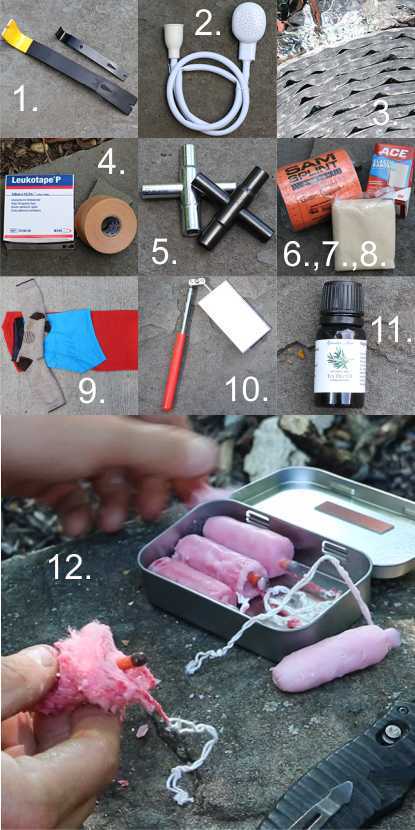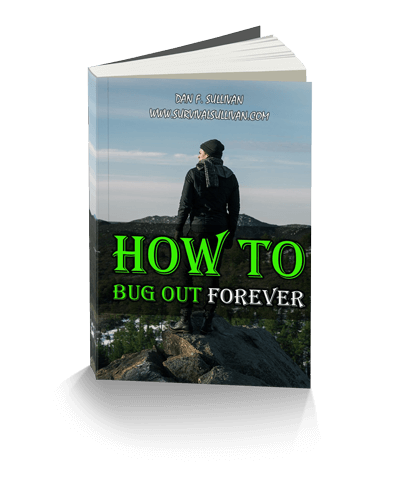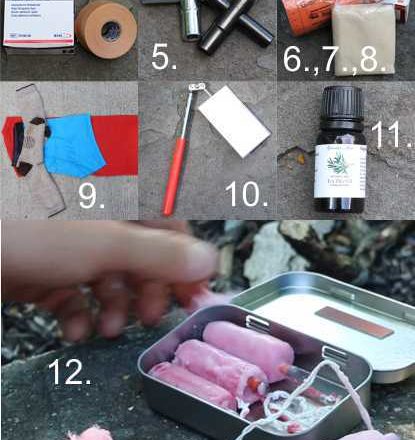Since hosting my free LIVE webinar titled 12 Things You Didn’t Know You Needed in Your Bug Out Bag, I continue to receive emails asking if the webinar was recorded. The answer is YES – I recorded the Free Webinar and have made it available by clicking the video screenshot below. It’s absolutely FREE to watch and can be played at any time.
I will also keep you posted about my upcoming webinar series (that is also FREE) titled The ABCs of BOBs where I cover all of the categories of a Bug Out Bag in detail. At the end of this 4 part webinar series, you will know everything there is to know about Bug Out Bags, what should go in them, how to reduce weight, and so much more. I will be covering the backpack choice, shelter, water, fire, food, first aid, tools and self defense. It will be a fantastic series so stay tuned for more information. Did I mention it’s FREE!
Many people also asked for a typed list of the 12 items I covered in
the webinar. Below is a list and photo series for reference. Enjoy!
12 Things You Didn’t Know You Needed in Your Bug Out Bag along with descriptions below:


Multi-Functional Pry Bar
The uses for a small metal pry bar are limitless. From digging holes to prying windows and rafters, these have more functions than I could ever list, both in the woods and in the city. The larger one is a Stanley brand and is only a few dollars at a local hardware store and is the one I’ve packed in my personal bag.
Universal Faucet Converter
This is originally designed to convert a faucet to a shower head. However, it has many more survival applications. If you’ve ever tried to fill your canteen (or any bottle) is a public restroom or sink faucet, you know it can be nearly impossible to do. The rubber slip-on gasket on this little unit makes filling from any faucet a breeze. The hose can even to used to fill larger water containers as well.
Reflective Insulation Barrier
In a Bug Out Bag where space is limited, a sleeping pad is oftentimes a luxury. However, a really decent sleeping pad can be cut from a roll of double reflective insulation. It’s kind of like a heavy duty bubble wrap layered between two emergency blankets. I spent only $20 on a 2 foot x 25 foot roll which will easily make enough sleeping pads for a family of 5. They aren’t going to last forever but for those limited on space and money, this sure makes a great little ground pad.
DIY Blister Kit using Leukotape
Unless you’re hiking with your Bug Out Bag on a regular basis, I can almost guarantee you’re going to get blisters if you have to hike with it in a disaster for more than about 5 miles. When it comes to blisters, this German made Leukotape is the bomb dot com. If you’ve used band-aids, moleskin or duct tape in the past then you already know they don’t hold up if your feet start to sweat or if they get wet. Leukotape is designed TO STICK TO SKIN and will stay on for weeks – EVEN if your feet sweat or get wet. Simply cover the blister or hot spot with a small piece of cut gauze and then place a piece of tape over it to protect the hot spot area. This is the best blister prevention and treatment tape I’ve ever used.
Sillcock Key
This handy little wrench, available at any big box hardware store, is designed specifically to turn on/off the outside water spigots located on commercial buildings, stores and restaurants. If you’ve ever noticed, these commercial establishments don’t have the easy turn knobs that most residential homes do. This little wrench has 4 different sizes to fit the various spigots out there. I’m certainly not encouraging theft, but I can’t imagine anyone would mind if you filled up your canteen during a disaster scenario.
SAM Splint, ACE Wrap Bandage, Cravat
It was a humbling day when I asked my very good friend, who happens to be the most decorated wilderness medic I know, what items should be in a Bug Out First Aid Kit (FAK). Of the 4 he mentioned, I only had 1 of them (a tourniquet). The other three I’m suggesting to you. The SAM Splint is a flexible splint that can effectively splint every bone in the human body. The ACE Wrap bandage is an elastic wrap that helps to put pressure on severe bleeding to help clotting process. The Cravat is a large triangular shaped piece of fabric that has many uses. Among them are a sling and ties for improvised splinting.
Skivvy Roll
A great way to save space in your BOB is a packing trick called a Skivvy Roll (watch the video above for a good demo of this). For a 3-Day Bug Out scenario, you’ll only probably need a fresh set of underwear, undershirt and socks. If you lay these out like shown in the photo above and roll them down tight, open ends of the socks can be pulled over each end to make a nice compact little tube. This can even be stored in a zip-lock back to keep it waterproof.
Mirror
A mirror is an absolute necessity for any BOB first aid kit. Especially if by yourself, a mirror helps to deal with issues on the face or in areas you can’t see on yourself (especially eyes). One of these “mechanics mirrors” with an expandable handle gives more flexibility when trying to see on your back, etc, or even around corners, discretely.
Tea Tree Oil
This tip comes from a friend of mine who recommended it for tick season. When a drop of Tea Tree Oil is placed on an embedded tick, the tick will back away and release by itself rather than you having to clasp it with tweezers and squeeze its guts into your skin. With all of the tick-borne illnesses these days, any help with ticks is a good thing.
Tampon Fire Rockets
I purchased these tampons at a health food store (EarthFare) and they are 100% cotton. Before being unwrapped they are about 2″ long and are smaller than a cotton ball. (BE SURE TO WATCH THE DEMO OF THIS SKILL IN MY VIDEO ABOVE) When opened up and frayed apart they are about 15 times the size of a cotton ball. As you can see in the photo, an incredible firestarter can be made by sharpening the end of a wooden match and shoving it into the flat end of the tampon. Then, the entire thing is dipped in wax until completely saturated and coated for waterproofing. When ready to use, simply break away the wax from the match head, fray out the cotton fibers and strike the match. I glued a striking pad on the inside of the tin where I store the fire rockets. These will burn anywhere from 15-30 minutes. They are incredible all weather fire starters.

Remember, it’s not IF but WHEN,

source : willowhavenoutdoor



